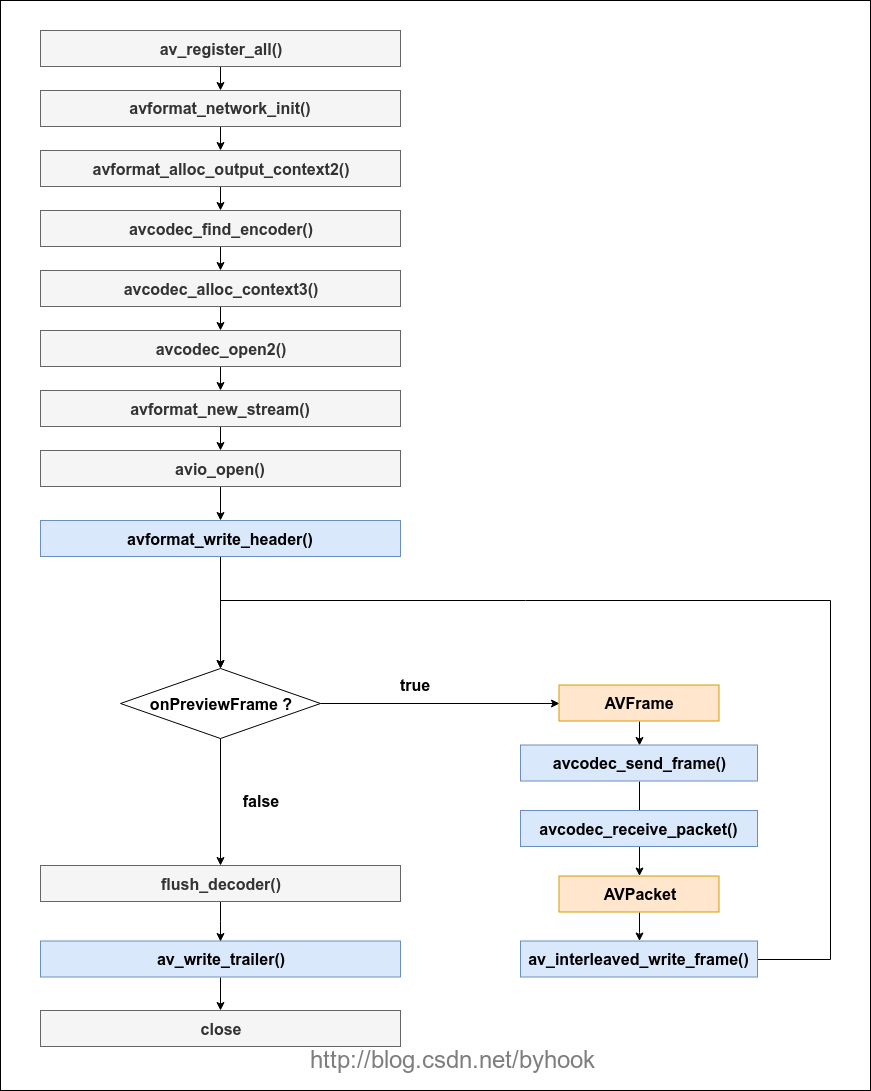android平臺下基於ffmpeg採集Camera資料編碼成H.264推流到RTMP伺服器
音視訊實踐學習
- android全平臺編譯ffmpeg以及x264與fdk-aac實踐
- ubuntu下使用nginx和nginx-rtmp-module配置直播推流伺服器
- android全平臺編譯ffmpeg合併為單個庫實踐
- android-studio使用cmake編譯ffmpeg實踐
- android全平臺下基於ffmpeg解碼MP4視訊檔案為YUV檔案
- android全平臺編譯ffmpeg支援命令列實踐
- android全平臺基於ffmpeg實現RTMP推流器推流本地MP4視訊
- android平臺下音訊編碼之編譯LAME庫轉碼PCM為MP3
- ubuntu平臺下編譯vlc-android視訊播放器實踐
- 圖解YU12、I420、YV12、NV12、NV21、YUV420P、YUV420SP、YUV422P、YUV444P的區別
- 圖解RGB565、RGB555、RGB16、RGB24、RGB32、ARGB32等格式的區別
- YUV420P、YUV420SP、NV12、NV21和RGB互相轉換並存儲為JPEG以及PNG圖片
- android全平臺編譯libyuv庫實現YUV和RGB的轉換
- android平臺下基於ffmpeg對相機採集的NV21資料編碼為MP4視訊檔案
- android平臺下基於ffmpeg採集Camera資料編碼成H.264推流到RTMP伺服器
概述
直播中推流和拉流是最核心的兩個功能,之前的一篇部落格記錄過關於推流本地的mp4檔案到推流伺服器,而本節內容主要記錄從相機採集資料到編碼H264格式,最後通過RTMP推流出去的一個過程,為了從簡單入手,本節內容暫不涉及音訊的編碼操作。
環境配置
作業系統:ubuntu 16.05
ndk版本:android-ndk-r16b
ffmpeg版本:ffmpeg-3.3.8
流程分析

開始實踐
android相機採集的資料預設是NV21格式的,並且前置攝像頭都是需要旋轉270度。StartPublish主要完成一些初始化工作,並且標記transform=true
EncodeBuffer來處理,完成編碼H264資料並推送出去。
void H264Publisher::StartPublish() {
//1.註冊所有元件
av_register_all();
//2.初始化網路
avformat_network_init();
//3.初始化輸出碼流的AVFormatContext
avformat_alloc_output_context2(&out_fmt, NULL, "flv", outputPath);
//4.查詢H.264編碼器
pCodec = avcodec_find_encoder(AV_CODEC_ID_H264);
if (!pCodec) {
LOGE("avcodec not found!");
return;
}
//5.分配編碼器並設定引數
pCodecCtx = avcodec_alloc_context3(pCodec);
//編碼器的ID,這裡是H264編碼器
pCodecCtx->codec_id = pCodec->id;
//編碼器編碼的資料型別
pCodecCtx->codec_type = AVMEDIA_TYPE_VIDEO;
//畫素的格式
pCodecCtx->pix_fmt = AV_PIX_FMT_YUV420P;
//前置攝像頭需要旋轉270度,寬和高要互換
pCodecCtx->width = height;
pCodecCtx->height = width;
pCodecCtx->framerate = (AVRational) {fps, 1};
pCodecCtx->time_base = (AVRational) {1, fps};
pCodecCtx->gop_size = 50;
pCodecCtx->max_b_frames = 0;
pCodecCtx->qmin = 10;
pCodecCtx->qmax = 50;
pCodecCtx->bit_rate = 100 * 1024 * 8;
pCodecCtx->level = 41;
pCodecCtx->refs = 1;
pCodecCtx->qcompress = 0.6;
if (out_fmt->oformat->flags & AVFMT_GLOBALHEADER) {
pCodecCtx->flags |= CODEC_FLAG_GLOBAL_HEADER;
}
//H.264
AVDictionary *opts = NULL;
if (pCodecCtx->codec_id == AV_CODEC_ID_H264) {
av_dict_set(&opts, "preset", "superfast", 0);
av_dict_set(&opts, "tune", "zerolatency", 0);
}
//6.開啟編碼器
int result = avcodec_open2(pCodecCtx, pCodec, &opts);
if (result < 0) {
LOGE("open encoder failed %d", result);
return;
}
//7.建立一個輸出流
pStream = avformat_new_stream(out_fmt, pCodec);
if (!pStream) {
LOGE("Failed allocating output outputPath");
return;
}
pStream->time_base.num = 1;
pStream->time_base.den = fps;
pStream->codecpar->codec_tag = 0;
if (avcodec_parameters_from_context(pStream->codecpar, pCodecCtx) < 0) {
LOGE("Failed av codec parameters_from_context");
return;
}
//8.開啟網路輸出流
if (avio_open(&out_fmt->pb, outputPath, AVIO_FLAG_READ_WRITE) < 0) {
LOGE("Failed to open output file!\n");
return;
}
//9.寫檔案頭部
result = avformat_write_header(out_fmt, NULL);
if (result < 0) {
LOGE("Error occurred when opening output URL %d", result);
return;
}
//初始化幀
pFrame = av_frame_alloc();
pFrame->width = pCodecCtx->width;
pFrame->height = pCodecCtx->height;
pFrame->format = pCodecCtx->pix_fmt;
int bufferSize = av_image_get_buffer_size(pCodecCtx->pix_fmt, pCodecCtx->width,
pCodecCtx->height, 1);
pFrameBuffer = (uint8_t *) av_malloc(bufferSize);
av_image_fill_arrays(pFrame->data, pFrame->linesize, pFrameBuffer, pCodecCtx->pix_fmt,
pCodecCtx->width, pCodecCtx->height, 1);
//建立已編碼幀
av_new_packet(&avPacket, bufferSize * 3);
//標記正在轉換
this->transform = true;
}
接著就是核心的編碼函式:
int H264Publisher::EncodeFrame(AVCodecContext *pCodecCtx, AVFrame *pFrame, AVPacket *avPacket) {
int ret = avcodec_send_frame(pCodecCtx, pFrame);
if (ret < 0) {
//failed to send frame for encoding
return -1;
}
while (!ret) {
ret = avcodec_receive_packet(pCodecCtx, avPacket);
if (ret == AVERROR(EAGAIN) || ret == AVERROR_EOF) {
return 0;
} else if (ret < 0) {
//error during encoding
return -1;
}
//AVFrame PTS
pFrame->pts = index;
//編碼資料
avPacket->stream_index = pStream->index;
AVRational time_base = out_fmt->streams[0]->time_base;//{ 1, 1000 };
avPacket->pts = index * (pStream->time_base.den) / ((pStream->time_base.num) * fps);
avPacket->dts = avPacket->pts;
avPacket->duration = (pStream->time_base.den) / ((pStream->time_base.num) * fps);
LOGI("Send frame index:%d,pts:%lld,dts:%lld,duration:%lld,time_base:%d,%d",
index,
(long long) avPacket->pts,
(long long) avPacket->dts,
(long long) avPacket->duration,
time_base.num, time_base.den);
avPacket->pos = -1;
//寫出資料
ret = av_interleaved_write_frame(out_fmt, avPacket);
if (ret != 0) {
LOGE("av_interleaved_write_frame failed");
}
av_packet_unref(avPacket);
index++;
}
return 0;
}
void H264Publisher::EncodeBuffer(unsigned char *nv21Buffer) {
uint8_t *i420_y = pFrameBuffer;
uint8_t *i420_u = pFrameBuffer + width * height;
uint8_t *i420_v = pFrameBuffer + width * height * 5 / 4;
//NV21轉I420
libyuv::ConvertToI420(nv21Buffer, width * height, i420_y, height, i420_u, height / 2, i420_v,
height / 2, 0, 0, width, height, width, height, libyuv::kRotate270,
libyuv::FOURCC_NV21);
pFrame->data[0] = i420_y;
pFrame->data[1] = i420_u;
pFrame->data[2] = i420_v;
//編碼H.264
EncodeFrame(pCodecCtx, pFrame, &avPacket);
}
我們結束推流的時候,將transform標記為false狀態,然後處理完最後一幀資料,最後關閉相關的控制代碼,回收資源。
void H264Publisher::StopPublish() {
//標記轉換結束
this->transform = false;
int result = EncodeFrame(pCodecCtx, NULL, &avPacket);
if (result >= 0) {
//封裝檔案尾
av_write_trailer(out_fmt);
//釋放記憶體
if (pCodecCtx != NULL) {
avcodec_close(pCodecCtx);
avcodec_free_context(&pCodecCtx);
pCodecCtx = NULL;
}
if (pFrame != NULL) {
av_free(pFrame);
pFrame = NULL;
}
if (pFrameBuffer != NULL) {
av_free(pFrameBuffer);
pFrameBuffer = NULL;
}
if (out_fmt != NULL) {
avio_close(out_fmt->pb);
avformat_free_context(out_fmt);
out_fmt = NULL;
}
}
}
注意:之前也說過了,android相機預設採集的資料是NV21格式的,我們是無法直接處理的,需要先將NV21格式轉換成Y420P格式的資料,並且旋轉270度(後置相機旋轉90度),得到最終的資料,送入編碼器中進行編碼成H264格式的資料,最後才通過av_interleaved_write_frame推流到伺服器上去。
用ffplay播放我們的區域網直播流rtmp://192.168.1.102:1935/onzhou/live
ffplay rtmp://192.168.1.102:1935/onzhou/live

存在的問題
目前只處理了視訊編碼推流部分,為了更方便的瞭解推流過程,音訊編碼暫未處理,後續會有音訊相關的內容。
參考:
專案地址:ffmpeg-camera-stream
https://github.com/byhook/ffmpeg4android
參考:
https://blog.csdn.net/leixiaohua1020/article/details/47056051
https://blog.csdn.net/leixiaohua1020/article/details/39803457
https://blog.csdn.net/bixinwei22/article/details/78770090
